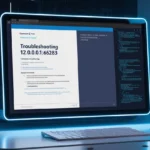Writing code is a creative and logical process, but errors, or “bugs,” are an inevitable part of the journey. Regardless of how experienced a developer is, debugging is a critical skill that requires patience, methodical thinking, and sometimes a bit of trial and error. In this guide, we’ll explore various techniques and strategies for finding and fixing errordomain=nscocoaerrordomain&errormessage=could not find the specified shortcut.&errorcode=4 in your code.
1. Understand the Types of Errors
Before diving into debugging, it’s essential to understand the different types of errors you might encounter:
- Syntax Errors: These occur when the code is not written in the correct format required by the programming language. These errors prevent the program from running altogether.
- Runtime Errors: These happen during the execution of the program. The code is syntactically correct but tries to perform an operation that is impossible (e.g., dividing by zero, accessing an undefined variable).
- Logical Errors: These are the hardest to detect. The program runs without crashing, but the output is incorrect due to flawed logic in the code.
2. Use a Debugger
Most modern integrated development environments (IDEs) come with built-in debugging tools. Debuggers allow you to execute your code line by line, inspect variables, and control the flow of the program. Here’s how to use a debugger effectively:
- Set Breakpoints: Breakpoints are points in your code where the execution will pause. You can place breakpoints at strategic locations to inspect the state of your application at that point.
- Step Through the Code: Once execution pauses at a breakpoint, use commands like “step over” or “step into” to go through your code one line at a time. This helps isolate where things are going wrong.
- Inspect Variables: Most debuggers allow you to view the value of variables during execution. This helps you check whether variables hold the expected values at different stages of the program.
3. Read and Interpret Error Messages
Error messages can often seem cryptic, but they provide essential information about what went wrong. When your code throws an error:
- Read the Full Stack Trace: A stack trace is a report that shows where the error occurred in the call stack. It helps pinpoint the file, function, and line number where the problem exists.
- Identify the Error Type: The error message typically specifies what kind of error occurred (e.g.,
TypeError,IndexOutOfBoundsError, etc.). Knowing this helps you understand whether it’s a syntax, runtime, or logical error. - Use Online Resources: Error messages often contain specific keywords or phrases that can be searched online. Sites like Stack Overflow frequently provide insights into common errors and how to fix them.
4. Check for Common Mistakes
Before diving into advanced debugging, always start by checking for common mistakes, such as:
- Typos: Misspelled variable names or function calls can easily lead to errors.
- Off-by-One Errors: These occur when using loops or array indices. For instance, iterating over a list but going out of its bounds can cause runtime errors.
- Incorrect Data Types: Mixing up data types, such as using a string where a number is expected, often leads to runtime or logical errors.
- Conditional Logic Errors: Ensure that your
ifstatements and loops have the correct conditions to avoid unexpected behavior.
5. Log Your Code
Logging is an invaluable tool for debugging. You can add print statements or use logging frameworks to record the flow of the program and the values of variables at various points. Here’s how to use logging effectively:
- Track Variable Values: Add print statements inside loops, conditional blocks, and functions to see how variables change over time.
- Log Important Events: Log when the program reaches critical parts of the code (e.g., when a function starts or finishes) to verify that the flow is correct.
- Use Logging Levels: If you’re using a logging framework, take advantage of logging levels (DEBUG, INFO, WARNING, ERROR) to categorize and control the verbosity of your logs.
6. Isolate the Problem Area
When faced with a large codebase, it’s helpful to isolate the problem. Narrow down the section of the code that is likely causing the error. Here’s how to approach this:
- Divide and Conquer: Start by commenting out or temporarily removing parts of the code to see if the error persists. This will help you isolate the section where the problem originates.
- Test Smaller Units: If you suspect a specific function or method is problematic, create a smaller test case that calls only that function with known inputs.
7. Write Unit Tests
Unit testing involves writing small test cases for individual functions or components in your code. Writing tests can help you catch bugs early and ensure that future changes don’t break existing functionality.
- Automated Testing Frameworks: Use testing frameworks (e.g., JUnit for Java, PyTest for Python, or Jest for JavaScript) to write automated tests. These tools can run your tests automatically and report any failures.
- Test Edge Cases: Be sure to test edge cases, such as empty inputs, maximum and minimum values, and unusual combinations of parameters.
8. Use Version Control
Version control systems (e.g., Git) are essential for tracking changes to your code and reverting to previous states if something breaks. Here’s how it helps in debugging:
- Compare Changes: When a new bug appears, you can compare the current version of the code with a previous, working version to identify what changes may have introduced the bug.
- Branching: Create branches for different features or bug fixes. This allows you to work on fixing an error without affecting the stable version of your project.
9. Rubber Duck Debugging
Rubber duck debugging involves explaining your code line by line to an inanimate object (or a colleague). By verbalizing your thought process, you may discover logical errors that you previously overlooked. The act of explaining forces you to slow down and think through the code more thoroughly.
10. Collaborate with Others
Sometimes, another pair of eyes can catch mistakes that you missed. Don’t hesitate to:
- Ask for Code Reviews: Peer reviews help in spotting errors or suggesting more efficient ways to write the code.
- Use Online Communities: If you’re stuck, online forums like Stack Overflow or GitHub Discussions can offer quick solutions and advice from other developers.
Conclusion
Debugging is an essential part of coding, and learning how to find and fix errors efficiently will make you a better developer. By using a debugger, interpreting error messages, logging code, and testing systematically, you can tackle even the most stubborn bugs. With practice, debugging becomes less daunting and more of a valuable problem-solving exercise.
Read Article about charizard:ttw47p-wxcy= pokemon



